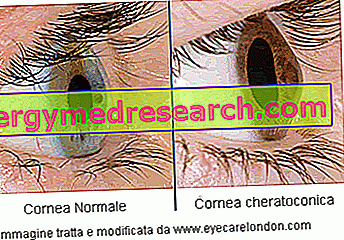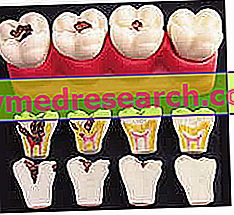Generality
Keratoconus is a disease that causes the deformation of the cornea (transparent ocular surface placed in front of the iris, which acts as a converging lens allowing the correct passage of light towards the internal structures of the eye).

Keratoconus does not allow the correct passage of light towards the internal ocular structures and modifies the refractive power of the cornea, causing distortion in vision.
Symptoms
To learn more: Symptoms of keratoconus
Keratoconus is a slowly progressive disease. The deformation of the cornea can affect one or both eyes, although the symptoms on one side can be markedly worse than the other (the disease can occur in an asymmetrical bilateral form).

The symptoms of keratoconus may include:
- Distorted vision;
- Increased sensitivity to light (photophobia);
- Mild eye irritation;
- Blurring of sight;
- Double vision with a closed eye (monocular polyopia).
Keratoconus often progresses slowly over 10-20 years before stabilizing.
During the evolution of the condition, the most common manifestations are:
- Visual acuity compromised at all distances;
- Reduced night vision;
- Increased myopia or kerotocone astigmatism;
- Frequent changes in prescription glasses;
- Inability to wear traditional contact lenses.
Occasionally, keratoconus may advance more rapidly, causing edema and corneal scarring. The presence of scar tissue on the surface of the cornea causes the loss of its homogeneity and transparency; as a result, opacity can occur, which significantly reduces eyesight.
Corneal anomalies or lesions associated with keratoconus can significantly affect the ability to perform simple tasks, such as driving, watching television, or reading a book.
Causes
The exact cause of keratoconus is not yet known. Some researchers believe that genetics plays an important role, as it is estimated that about 10-15% of affected people present at least one family member with the same condition (evidence of genetic transmission).
Furthermore, keratoconus is often associated with:
- corneal injury or damage: vigorous rubbing of the eye, chronic irritation, wearing contact lenses for prolonged periods, etc.
- Other eye conditions, including: retinitis pigmentosa, premature retinopathy and spring keratoconjunctivitis.
- Systemic diseases: Leber congenital amaurosis, Ehlers-Danlos syndrome, Down syndrome and imperfect osteogenesis.
Some researchers believe that an imbalance of enzymatic activity inside the cornea can make it more vulnerable to oxidative damage caused by free radicals and other oxidizing species. Particular proteases show signs of increased activity and act by breaking part of the cross-links between the collagen fibers in the stroma (deepest part of the cornea). This pathological mechanism would produce a weakening of the corneal tissue, with a consequent reduction in thickness and biomechanical resistance.
Diagnosis
Early diagnosis can prevent further damage and loss of vision. During a routine eye exam, the doctor asks the patient questions about visual symptoms and any family predisposition, then checks for irregular astigmatism and other problems by measuring the refraction of the eye . The ophthalmologist can ask to look through a device, to determine which combination of optical lenses allows clearer vision. A keratometer is used to measure the curvature of the external surface of the cornea and the extent of the refractive defects. In severe cases, this tool may not be sufficient to make a correct diagnosis.
Further diagnostic tests may be necessary to determine the shape of the cornea. These include:
- Retinoscopy: evaluates the projection and reflection of a light beam on the patient's retina, examining how this is concentrated on the back of the eye, even with the forward and backward inclination of the light source. Keratoconus is among the ocular conditions that show a scissor reflex (two bands approach and take distance like the blades of a pair of scissors).
- Slit-lamp examination : if the suspicion of keratoconus emerges from the retinoscopy this examination can be performed. The doctor directs a beam of light into the eye and uses a low-power microscope to visualize the eye structures and look for potential defects in the cornea or other parts of the eye. The slit lamp examines the shape of the corneal surface and looks for other specific features of keratoconus, such as the Kayser-Fleischer ring. This consists of a yellow-brown-greenish pigmentation on the periphery of the cornea, caused by the deposition of hemosiderin within the corneal epithelium and evident on examination with a cobalt-blue filter. The Kayser-Fleischer ring is present in 50% of cases of keratoconus. The test can be repeated after the administration of a mydriatic eye drops to dilate the pupils and visualize the posterior part of the cornea.
- Keratometry: this non-invasive technique projects a series of concentric rings of light onto the cornea. The ophthalmologist measures the reflection of the light beams to determine the curvature of the surface.
- Corneal topography (corneal mapping): this diagnostic investigation allows the topographic map of the anterior surface of the eye to be generated. A computerized optical instrument is used to project light patterns onto the cornea and measure its thickness. When keratoconus is in its early stages, the corneal topography shows any sprains or scars on the cornea. Alternatively, optical coherence tomography (OCT) can be used.
Treatment
The treatment of keratoconus often depends on the severity of the symptoms and how quickly the condition is progressing. During the initial phase, the visual defect can be corrected with soft or semi-rigid eyeglasses and contact lenses. However, over time the disease inevitably thins the cornea, giving it an increasingly irregular shape that could make these devices no longer sufficient. Advanced keratoconus may require a corneal transplant.
Rigid gas permeable contact lenses (RGP)
When keratoconus progresses, RPG lenses improve vision by adapting to the irregular shape of the cornea, to make it a smooth refractive surface. These devices provide a good level of visual correction but do not stop the progression of the disease. At first, this type of rigid lens can cause some patient discomfort, but most people adapt within a week or two.
Piggy-back contact lenses (twin lenses)
If rigid gas permeable contact lenses are not tolerated by the patient, some ophthalmologists recommend a combination of two different types of contact lenses to be applied to the same eye: a soft lens (usually disposable) and an RGP to overlap the previous one. Typically, the soft lens acts as a bearing for the stiffer lens.
Scleral and semi-scleral contact lenses
Scleral lenses are prescribed for cases of advanced or very irregular keratoconus. These gas-permeable devices have larger diameters, which allow their edges to adhere to the sclera (white part of the eye). Scleral contact lenses can offer better stability and are particularly suitable for handling by patients with reduced dexterity, such as the elderly. Semi-scleral lenses cover a minor portion of the sclera. Many people adopt these contact lenses for comfort and lack of pressure applied to the surface of the eye.
Corneal inserts
Corneal inserts are small semicircular devices that are placed in the peripheral part of the cornea, to help restore the normal shape of the front surface of the eye. The application of corneal grafts slows the progression of keratoconus and improves visual acuity, also acting on myopia. Typically, corneal inserts are used when other therapeutic options, such as contact lenses and eyeglasses, fail to improve vision. Inserts are removable and replaceable; the surgical procedure lasts only ten minutes. If the keratoconus continues to progress even after the insertion of these prostheses, a corneal transplant may be necessary.
Corneal reticulation
Corneal cross-linking is an emerging treatment and further studies are needed before it becomes widely available. This procedure consists of strengthening the corneal tissue to prevent further surface protrusion of the cornea. Corneal collagen crosslinking with riboflavin consists in applying a solution activated by a special lamp that emits ultraviolet light (UVA) for about 30 minutes. The procedure promotes the strengthening of collagen fibers in the stromal layer of the cornea, which recovers part of the lost mechanical resistance. Before corneal cross-linking with riboflavin the epithelial layer (the external portion of the cornea) is generally removed to increase the penetration of riboflavin into the stroma. Another method, known as transepithelial corneal cross-linking, is used in a similar way, but the epithelial surface is left intact.
Corneal transplantation
When all previous treatment options fail, the only treatment option is corneal transplantation, also known as perforating keratoplasty (traditional method). This surgery is necessary only in about 10-20% of the cases of keratoconus and is indicated above all in the presence of corneal scars or extreme thinning. The cornea, in fact, has very limited possibilities for repair and any anomalies or corneal lesions must be treated in order to prevent the consequences. The procedure involves the removal of an entire portion of the cornea, to replace it with the tissue of a healthy donor, in the hope of restoring sight and preventing blindness. A necessary condition for the success of the intervention is that the corneas are removed within five hours of the donor's death. Upon completion of the procedure, some sutures allow the transplanted cornea to be held in place.
After a perforating keratoplasty, it may take up to a year to recover good vision. Cornea transplantation helps alleviate the symptoms of keratoconus, but cannot restore perfect vision. In most cases, in fact, glasses and contact lenses could be prescribed for better comfort.
Surgery involves risks, but among all the conditions that require a corneal transplant, keratoconus has the best prognosis for sight. As an alternative to perforating keratoplasty, the lamellar method can be performed which consists of a partial transplant, where only a part of the surface of the cornea is replaced and the inner layer is preserved (endothelium).
Note. Refractive surgery can be dangerous for people with keratoconus. Anyone with even a small degree of corneal dystrophy should not undergo surgery to correct refractive defects, such as LASIK or PRK.
Complications
Complications of keratoconus may include:
- Partial or total blindness;
- Change in the shape of the eye;
- Additional eye problems.
Corneal transplant complications may include:
- Surgical wound infection;
- Transplant rejection;
- Secondary glaucoma.



